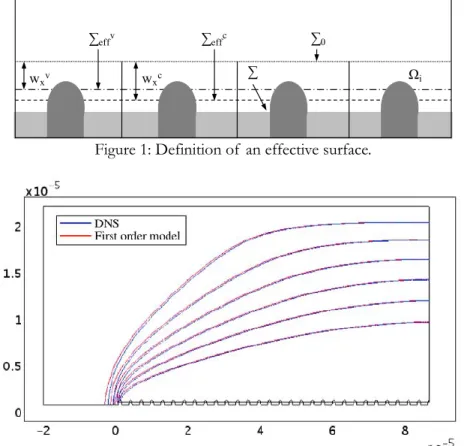Any correspondence concerning this service should be sent to the repository administrator:
staff-oatao@inp-toulouse.fr
OATAO is an open access repository that collects the work of Toulouse researchers and makes it freely available over the web where possible.
This is an author-deposited version published in: http://oatao.univ-toulouse.fr/ Eprints ID: 9091
To cite this version:
Guo, Jianwei and Veran-Tissoires, Stéphanie and Quintard, Michel Effective
Surface and Boundary Condition for Heterogeneous Salt Media with Insoluble
Material. (2013) In: 5th International Conference on porous media & Annual
meeting of the International Society for Porous Media (InterPore), 22-24 May
2013, Prague, Czech Republic.
Effective Surface and Boundary Condition for Heterogeneous
Salt Media with Insoluble Material
J. Guoa, S. Veran-Tissoiresa,b, M. Quintarda,b
a Université de Toulouse; INPT, UPS; IMFT (Institut de Mécanique des Fluides de Toulouse); Allée Camille Soula, F-31400 Toulouse, France
b CNRS; IMFT; F-31400 Toulouse, France
Key words: heterogeneous surface, multi-scale decomposition, effective surface
Several mechanisms, such as dissolution of salt material or drying of porous media, involve transport from a heterogeneous, rough surface characterized by areas in thermodynamic equilibrium with the surrounding fluid and areas of no flux (insoluble material, solid grains in the porous medium) [1], [2]. In general, the characteristic length-scale of the surface is much smaller than the scale of the process under investigation. To deal with this multi-scale aspect, the engineering practice is to replace the heterogeneous, rough surface by a homogeneous, smooth surface, the “effective” surface, over which is applied the Dirichlet condition corresponding to thermodynamic equilibrium. This idea has been checked partially against direct numerical simulation of the small-scale problem, in particular in the case of drying problems.
In this study, we develop a more complete theory of the concept of effective surface applied to such transport problems. The typical example under investigation corresponds to the laminar flow over a soluble salt medium which contains insoluble materials. To develop the concept of effective surface we apply a multi-domain decomposition approach [3], [4], [5]. We first decompose the system, by introduction of an arbitrary interface Σ0, into a macro-scale subdomain Ω0 where the variables are
smooth and a series of micro-scale Ωi subdomains which contain all the roughnesses (cf. Figure 1).
We then make estimates of velocity and concentration at the micro-scale with an asymptotic expansion of deviation terms with respect to macro-scale velocity and concentration fields. Closure problems for the deviations are obtained and used to study the position of the effective surface and the related boundary conditions.
After resolution of the closure problems, it is shown that the boundary condition for Navier-Stokes equations is of the Navier type (already known from the literature), and of a mixed reactive type, for the mass balances. The effective surface can be positioned in different places, for instance in order to recover a no-slip condition. The associated surface is denoted Σeffv, and the effective boundary
conditions are
0
0
u
at Σeffv ⑴ -nDc0 keff(c0-ceq) at Σeffv ⑵where
u
0andc
0 denote respectively the velocity and concentration in the first order effective model,while
c
eq is the thermodynamic equilibrium concentration,n
is the normal vector pointing from thefluid towards the solid, D is the diffusion coefficient and
k
eff is defined as an effective mass exchangecoefficient. If one wants to recover the original equilibrium condition, the position of the related effective surface Σeffc is different from Σeffv. In that case we have
eq c c0 at Σeffc (3) 0 0
n
(
w
-
w
)
u
u
v x c x
at Σeffc (4)where
w
xc andw
xv denote respectively the distance from Σ0 to Σeffc and Σeffv. Based on numericaleffective surface position, for various geometries, Reynolds and Schmidt numbers. Finally, we make a comparison between the numerical results obtained with this effective model and those from direct numerical simulations. This allows us to discuss the practical implementation of the effective surface model, in particular the optimal position of the surface. An example of the obtained concentration fields is shown in Figure 2. Concentration contours from direct numerical simulation and the first order effective model are well superposed, apart from a small entrance region where conditions for upscaling break down, which creates a small but acceptable discrepancy. This demonstrates the interest of using an effective surface model, characterized by a homogeneous, smooth surface, to reproduce in a bulk sense flows over heterogeneous, rough surfaces.
Ω0 ∑0 ∑effv wxv wxc ∑ ∑effc Ωi
Figure 1: Definition of an effective surface.
Figure 2: Concentration field contours for the initial and the effective domain, for a flow entrance velocity of 1m∙s-1 and Schmidt number of 1.
References
[1] M. Quintard and S. Whitaker. Dissolution of an immobile phase during flow in porous media. Industrial & Engineering Chemistry Research, 38(3), 833-844(1999).
[2] M. Suzuki and S. Maeda, On the mechanism of drying of granular bed - Mass transfer from discontinuous source. Journal of Chemical Engineering of Japan, 1(1), 26-31(1968).
[3] Y. Achdou, O. Pironneau and F. Valentin. Effective boundary conditions for laminar flows over periodic rough boundaries. Journal of computational physics, 147, 187-218(1998).
[4] S. Veran, Y. Aspa and M. Quintard. Effective boundary conditions for rough reactive walls in laminar boundary layers. International Journal of Heat and Mass Transfer, 52, 3712-3725(2009).
[5] C. Introïni, M. Quintard and F. Duval. Effective surface modelling for momentum and heat transfer over rough surfaces: Application to a natural convection problem. International Journal of Heat and Mass Transfer, 54, 3622-3641(2011).
